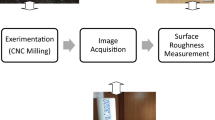Abstract
Milling workpiece present a regular pattern when they are correctly machined. However, if some problems occur, the pattern is not so homogeneous and, consequently, its quality is reduced. This paper proposes a method based on the use of texture descriptors in order to detect workpiece wear in milling automatically. Images are captured by using a boroscope connected to a camera and the whole inner surface of the workpiece is analysed. Then texture features are computed from the coocurrence for each image. Next, feature vectors are classified by 4 different approaches, Decision Trees, K Neighbors, Naïve Bayes and a Multilayer Perceptron. Linear discriminant analysis reduces the number of features from 6 to 2 without loosing accuracy. A hit rate of 91.8% is achieved with Decision Trees what fulfils the industrial requirements.
Access this chapter
Tax calculation will be finalised at checkout
Purchases are for personal use only
Similar content being viewed by others
References
Arivazhagan, S., Ganesan, L.: Texture classification using wavelet transform. Pattern Recogn. Lett. 24(9–10), 1513–1521 (2003)
Bustillo, A., Correa, M.: Using artificial intelligence to predict surface roughness in deep drilling of steel components. J. Intell. Manufact. 23(5), 1893–1902 (2012). https://doi.org/10.1007/s10845-011-0506-8
Chaves, M.L., Vizán, A., Márquez, J.J., Ríos, J.: Inspection model and correlation functions to assist in the correction of qualitative defects of injected parts. Polym. Eng. Sci. 50(6), 1268–1279 (2010). https://doi.org/10.1002/pen.21647, https://onlinelibrary.wiley.com/doi/abs/10.1002/pen.21647
Dai, Y., Zhu, K.: A machine vision system for micro-milling tool condition monitoring. Precis. Eng. 52, 183–191 (2018). https://doi.org/10.1016/j.precisioneng.2017.12.006, http://www.sciencedirect.com/science/article/pii/S0141635917302817
Dunwell Tech Inc.: Dinocapture 2.0: microscope imaging software (2019). https://www.dinolite.us/dinocapture
Dutta, S., Pal, S., Mukhopadhyay, S., Sen, R.: Application of digital image processing in tool condition monitoring: a review. CIRP J. Manufact. Sci. Technol. 6(3), 212–232 (2013). https://doi.org/10.1016/j.cirpj.2013.02.005, http://www.sciencedirect.com/science/article/pii/S1755581713000072
Haralick, R., Shanmugan, K., Dinstein, I.: Texture features for image classification. IEEE Syst. Man Cybern. 3(6), 610–621 (1973)
Hu, H., Liu, Y., Liu, M., Nie, L.: Surface defect classification in large-scale strip steel image collection via hybrid chromosome genetic algorithm. Neurocomputing 181, 86–95 (2016). https://doi.org/10.1016/j.neucom.2015.05.134, http://www.sciencedirect.com/science/article/pii/S0925231215018482. Big Data Driven Intelligent Transportation Systems
Li, L., An, Q.: An in-depth study of tool wear monitoring technique based on image segmentation and texture analysis. Measurement 79, 44–52 (2016). https://doi.org/10.1016/j.measurement.2015.10.029, http://www.sciencedirect.com/science/article/pii/S0263224115005631
López-Estrada, L., Fajardo-Pruna, M., Sánchez-González, L., Pérez, H., Fernández-Robles, L., Vizán, A.: Design and implementation of a stereo vision system on an innovative 6DOF single-edge machining device for tool tip localization and path correction. Sensors 18(9) (2018). https://doi.org/10.3390/s18093132, http://www.mdpi.com/1424-8220/18/9/3132
Park, G.H., Cho, H.H., Choi, M.R.: A contrast enhancement method using dynamic range separate histogram equalization. IEEE Trans. Consum. Electron. 54(4), 1981–1987 (2008)
Szydłowski, M., Powałka, B., Matuszak, M., Kochmański, P.: Machine vision micro-milling tool wear inspection by image reconstruction and light reflectance. Precis. Eng. 44, 236–244 (2016). https://doi.org/10.1016/j.precisioneng.2016.01.003, http://www.sciencedirect.com/science/article/pii/S0141635916000052
Zuiderveld, K.: Contrast limited adaptive histogram equalization. In: Heckbert, P.S. (ed.) Graphics Gems IV, pp. 474–485. Academic Press Professional Inc., San Diego, CA, USA (1994). http://dl.acm.org/citation.cfm?id=180895.180940
Acknowledgements
We gratefully acknowledge the financial support of Spanish Ministry of Economy, Industry and Competitiveness, through grant DPI2016-79960-C3-2-P.
Author information
Authors and Affiliations
Corresponding author
Editor information
Editors and Affiliations
Rights and permissions
Copyright information
© 2019 Springer Nature Switzerland AG
About this paper
Cite this paper
Castejón-Limas, M., Sánchez-González, L., Díez-González, J., Fernández-Robles, L., Riego, V., Pérez, H. (2019). Texture Descriptors for Automatic Estimation of Workpiece Quality in Milling. In: Pérez García, H., Sánchez González, L., Castejón Limas, M., Quintián Pardo, H., Corchado Rodríguez, E. (eds) Hybrid Artificial Intelligent Systems. HAIS 2019. Lecture Notes in Computer Science(), vol 11734. Springer, Cham. https://doi.org/10.1007/978-3-030-29859-3_62
Download citation
DOI: https://doi.org/10.1007/978-3-030-29859-3_62
Published:
Publisher Name: Springer, Cham
Print ISBN: 978-3-030-29858-6
Online ISBN: 978-3-030-29859-3
eBook Packages: Computer ScienceComputer Science (R0)




